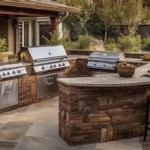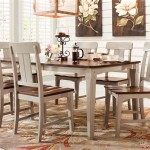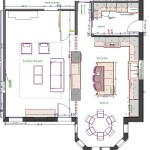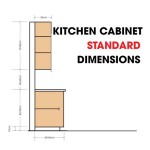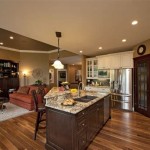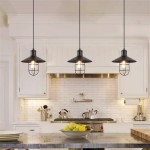Mixed Metal Kitchen Cabinet Hardware
Mixed metal finishes in kitchen design have become increasingly popular, offering a dynamic and personalized aesthetic. This trend extends to cabinet hardware, where the strategic combination of metals like brass, nickel, chrome, and black creates visual interest and elevates the overall kitchen style. Selecting and incorporating mixed metal hardware requires thoughtful consideration to achieve a cohesive and balanced look.
Understanding Metal Finishes
Before delving into the art of mixing metals, it's essential to understand the different types of finishes available. Each metal possesses unique characteristics that contribute to the overall kitchen design. Brass, known for its warm, golden tones, can range from bright and polished to a more aged, antique appearance. Nickel offers a cooler, silvery tone, with variations including brushed nickel, satin nickel, and polished nickel. Chrome, a highly reflective and durable finish, provides a sleek, modern look. Black finishes, often achieved through powder coating or other specialized processes, create a bold, contemporary statement. Understanding these nuances allows for informed decisions when mixing and matching.
Creating a Balanced Look with Mixed Metals
Achieving harmony with mixed metal hardware involves establishing a dominant metal and one or two accent metals. The dominant metal typically appears in the largest quantities, setting the overall tone for the space. This might be the finish chosen for cabinet knobs and pulls, or perhaps the faucet and other larger fixtures. Accent metals, used more sparingly, add visual interest and create layers within the design. For instance, if brushed nickel is the dominant metal for cabinet hardware, black might be used for the light fixtures and faucet, adding a touch of contrast and sophistication.
Maintaining balance also involves considering the existing metal finishes in the kitchen. Appliances, lighting fixtures, and plumbing fixtures already present in the space should inform the selection of cabinet hardware. If the existing appliances are stainless steel, incorporating nickel or chrome hardware can create a seamless and cohesive look. Alternatively, if the appliances have black or slate finishes, introducing black cabinet hardware can complement the overall aesthetic. The goal is to create a sense of flow and continuity throughout the kitchen.
Strategic Placement of Hardware
The placement of mixed metal hardware plays a crucial role in achieving a well-balanced aesthetic. A common approach is to use the dominant metal for the majority of cabinet hardware, such as knobs and pulls, and then incorporate the accent metal in more specific areas. For example, if brass is the dominant metal, black knobs and pulls could be used on the perimeter cabinets, while brass knobs could be used on the island cabinets for a subtle contrast. This technique creates a focal point and adds visual interest without overwhelming the space.
Another approach is to use different metals for different types of hardware. For example, knobs could be in one finish, while pulls are in another. This can create a subtle yet effective contrast. Similarly, different finishes could be used for drawers versus doors. These subtle variations add depth and complexity to the overall design. Careful consideration of hardware placement ensures a cohesive and visually appealing result.
Considering the Kitchen Style
The overall style of the kitchen significantly influences the choice of mixed metal hardware. In a modern kitchen, sleek and polished finishes like chrome and nickel, paired with black accents, can create a sophisticated and minimalist look. In a more traditional or farmhouse-style kitchen, warmer metals like brass and antique bronze, combined with black or pewter, can contribute to a cozy and inviting atmosphere. Understanding the design principles of different kitchen styles allows for a more informed selection of hardware that complements the overall aesthetic.
The color palette of the kitchen also plays a role in selecting hardware finishes. In a kitchen with a light and airy color scheme, lighter metal finishes like polished nickel or chrome can enhance the sense of brightness. In a kitchen with darker cabinets or countertops, warmer metals like brass or bronze can add depth and warmth. Considering the interplay of colors and finishes ensures a harmonious and balanced result.
Maintaining Cohesion Through Similar Undertones
A key principle in successfully mixing metals is considering the undertones of each finish. Metals with similar undertones, even if they are different colors, can create a sense of cohesion. For example, brushed nickel and polished chrome, while different in their level of shine, both have cool, silvery undertones, allowing them to blend seamlessly. Similarly, antique brass and oil-rubbed bronze, while different in color, share warm, earthy undertones, creating a harmonious pairing. Paying attention to these undertones ensures a cohesive and well-balanced look.
Utilizing a mood board or gathering samples of different metal finishes can be invaluable in visualizing the final result. This allows for experimentation with different combinations and ensures that the chosen metals complement each other and the overall kitchen design. Consulting with a design professional can also provide valuable insights and guidance in selecting and incorporating mixed metal hardware. With careful planning and attention to detail, mixed metal hardware can elevate the kitchen design, adding a touch of personality and sophistication.

How To Mix Metals In Your Kitchen Stefana Silber

How To Mix Metals In Your Kitchen Stefana Silber
6 Tips For Using Mixed Metals In Your Home Signature Hardware

Q A Mixing Metals In The Kitchen Becki Owens

A Simple Guide To Mixing Metals In The Kitchen Jane At Home

A Simple Guide To Mixing Metals In The Kitchen Jane At Home

Trending Mixed Metal Finishes In Kitchens And Bathrooms Model Remodel

Best Guide How To Mix Metals In Kitchen Clark Aldine 2024
The Latest Kitchen Trend Mixing Metals Cafe Appliances

Design School All You Need To Know About Mixing Metals

